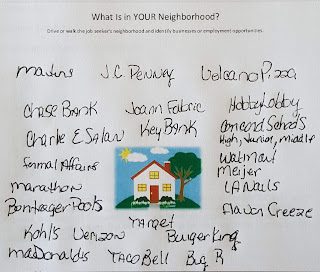What's next?
Take a Look Around
 We previously blogged about the home visit, sharing examples of a “Meet and Greet” along with “Tips and Tricks for Making You and Your Job Seeker More Comfortable.” Need a refresher? Review “’What’s Up?’ An In-Depth Look at the Meet and Greet.” When scheduling the home visit, you could also arrange with your job seeker to do some neighborhood mapping.
We previously blogged about the home visit, sharing examples of a “Meet and Greet” along with “Tips and Tricks for Making You and Your Job Seeker More Comfortable.” Need a refresher? Review “’What’s Up?’ An In-Depth Look at the Meet and Greet.” When scheduling the home visit, you could also arrange with your job seeker to do some neighborhood mapping. 
What is neighborhood mapping? It's simply taking a tour of your job seeker’s immediate neighborhood and nearby community. You may want to tour the neighborhood prior to your first home visit or as an activity with the job seeker or both. Your choice. The idea is to look for businesses that might be an employment option, a work experience opportunity, or a place to try a situational assessment.

Ask yourself, “What types of businesses are near the home?” Are they industrial, retail, hospitality? Are they mostly big box stores? If there are no businesses within a reasonable distance from the job seeker’s home, how far would he or she need to travel? Another important observation to make is the “culture” you can see and feel in the neighborhood. Does it feel friendly? Do people greet one another or keep to themselves? Is there an appreciation for well-kept lawns and clean streets?
Point A to Point B and Back Home
 Neighborhood mapping also involves exploring transportation options by thinking about the following questions: What is available in the area? Is there a bus line? How often do buses run? How early do they pick up in the morning, and how late do they run each day? Do ridesourcing companies (e.g., Uber or Lyft) cater to the area? Is there a bike lane? Is there a train? What safety concerns might be present in their neighborhood? Is there a sidewalk? Do they have to cross a busy street to catch a bus? Is it safe to walk the neighborhood alone? Are there Crime Watch signs posted?
Neighborhood mapping also involves exploring transportation options by thinking about the following questions: What is available in the area? Is there a bus line? How often do buses run? How early do they pick up in the morning, and how late do they run each day? Do ridesourcing companies (e.g., Uber or Lyft) cater to the area? Is there a bike lane? Is there a train? What safety concerns might be present in their neighborhood? Is there a sidewalk? Do they have to cross a busy street to catch a bus? Is it safe to walk the neighborhood alone? Are there Crime Watch signs posted? Keep a List
 During the home visit, you may have asked for names of neighbors who may know the job seeker well. Exploring the neighborhood with the job seeker will help you identify those neighbors who could be beneficial to the job seeker’s quest for employment.
During the home visit, you may have asked for names of neighbors who may know the job seeker well. Exploring the neighborhood with the job seeker will help you identify those neighbors who could be beneficial to the job seeker’s quest for employment. When you first met with your job seeker you also probably learned about activities the job seeker regularly participates in, such as grocery shopping, classes at the YMCA, or community gardening. Touring the neighborhood with the job seeker can verify participation in activities, as well as help you identify additional places, resources, and services that can provide opportunities for Discovery activity planning. During that drive around the neighborhood, your job seeker may also talk about other people they know, like the trainer at the YMCA or the hairstylist at the local salon. That may give you an opportunity to connect with more people who know your job seeker.
Employment specialists can track neighborhood mapping information by recording the business names on their smartphone, taking pictures, or creating a list with good old paper and pencil.
Our thanks to Goodwill Michiana for allowing us to share some examples of neighborhood mapping from northern Indiana.
